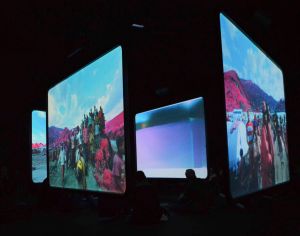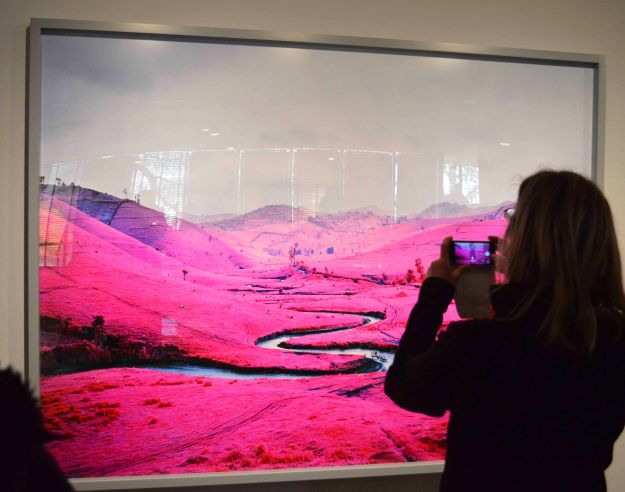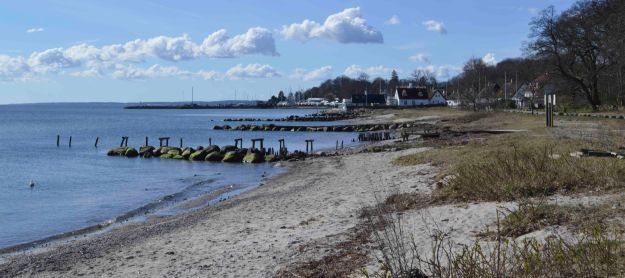Colour blindness comes in a version where green and red are indistinguishable. I cannot imagine not being able to see the many greens that colour spring and summer or the reds of tulips and cherry blossoms that are starting to show.
Richard Mosse (1980) is an Irish artist whose work The Enclave (2013) is exhibiting at Louisiana Museum of Modern Art presently. This work explores the war in the Democratic Republic of Congo, changing hues of green to hues of red and pink. Mosse used the now discontinued Kodak Aerochrome to film events in DRC – the US Army used this surveillance film to show invisible infrared light, turning green into red and pink to detect camouflage. This war is largely ignored by Western media and therefore largely unknown outside Congo and Rwanda, even though more than 5.4 million people have died in this war since 1998.
When you step into the exhibition space, a number of large photographic prints greet you with their unreal red hues. At first, you see beautiful landscapes distorted by the odd colours. For example, Platon, North Kivu (2012) shows a meandering river valley and rolling pink hills contrasted by an ominous grey sky. You look at the vignettes of huts built out of all kinds of materials. And you examine the man, dressed in pink, his head covered by a bright red scarf, standing in a path in a small town with pink hills in the background. The machine gun gives it away – this is war, this is Alternative Ulster (2012). Going back to the beautiful landscapes and you realise that unimaginable horrors take place and the colour palette masks a reality that is dark and terrible.

Six screens are hung in a large dark space with an impressively large sound track, disorienting the viewer as to which part of the horror to watch – Richard Mosse: The Enclave (2013). Photo: Mick 2015.
Inside the dark room where The Enclave (2013) is shown, six screens are installed, running disparate footage on each. It is disorienting and the stories never quite come together: the story of this indescribable war never does. You watch what you can of the moving images and think they ought to be out of a fictional movie, though you know they are reality for real people. The haunting sound track by Ben Frost literally shakes you to the bones.
In her piece in Louisiana Magazine, Den Usynlige Krig (The Invisible War, 2014), Museum director Marie Laurberg connects the atrocities and conflict in today’s Democratic Republic of Congo with its colonial past and Western interference with its independence. Colonisation was all about ivory and rubber, exploitation and violence and money into Belgian King Leopold’s bulging bank account and during independence protection of Western interests in the riches of Congo did not equate to protection of its peoples.
Joseph Conrad’s Heart of Darkness (1899) is a tale of colonialism and ivory trade out of Congo. And of life and death. Englishman Marlow talks to other sailors about his experience of travelling up the Congo River to fetch Kurtz, an almost mythical character and successful ivory trader, whose reputation is so much more impactful than meeting his earthly remains toward the end of his life. From this experience Marlow’s outlook is dark: all you can hope from from life “is some knowledge of yourself – that comes too late – a crop of unextinguishable regrets.” Conrad’s writing is dense and difficult, yet some passages are written with the eye of the keen observer – Conrad was captain of a steamer travelling up the Congo River in 1890.
Conrad has been criticised for depicting the indigenous peoples of Congo as dark and homogeneous, when in reality the randomly created country the size of Western Europe was heterogeneous with more than 240 languages spoken. Conrad juxtaposes civilised Europeans with savage indigenous peoples of Congo and while he – ambiguously – criticises colonialism, his price is a uniform dark unknown. I deeply sympathise with the victims of this violent history of colonisation and the equally violent post-colonial struggle of combining such diversity into a working democratic system. I deplore the interference to protect western economic interests which led the country to its current situation, so eloquently and brutally uncovered by Mosse’s work. Where life is cheap and lullabies count the day’s victims and the blessings for still being alive.
Political critique aside, Conrad’s native language was Polish, though he wrote this book in English, which he did not learn until he was 20. This makes his writing even more interesting – its haunting nature, its detailed descriptions, its hallucinatory effects in part come from his struggle with the English language. With effort, perhaps I too could write in either language with similar results. After 24 years abroad in Australia, I find myself struggling with both the Danish and the English language. I have pertinent words and phrases in Danish for which I cannot find the English equivalent, and vice versa. Translation is not an option; translation always falls just short of the meaning I seek to convey. I have written before about the connection between memory and language and the inherent problem of describing in one language experiences had in another. However, rather than being a weakness, perhaps my bilingualism is an opportunity to use either language in ways that are fresh and different.
Mosse’s language too is new and different. with it, he makes visible a conflict that has been invisible for too long. With shocking pink, he alerts us to the plight of so many victims of this forgotten war with no centre, no explanatory narrative. Go see it if you have the chance.




Pingback: Danish diversity | Pied-à-terre CPH